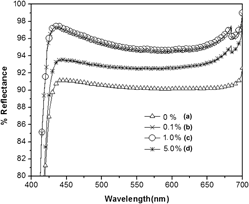Crossref Citations
This article has been cited by the following publications. This list is generated based on data provided by
Crossref.
Joyce Stella, R.
Thirumala Rao, G.
Pushpa Manjari, V.
Babu, B.
Rama Krishna, Ch.
and
Ravikumar, R.V.S.S.N.
2015.
Structural and optical properties of CdO/ZnS core/shell nanocomposites.
Journal of Alloys and Compounds,
Vol. 628,
Issue. ,
p.
39.
Manoharan, K.
and
Venkatachalam, P.
2015.
Photoelectrochemical performance of dye sensitized solar cells based on aluminum-doped titanium dioxide structures.
Materials Science in Semiconductor Processing,
Vol. 30,
Issue. ,
p.
208.
Murashkina, Anna A.
Murzin, Petr D.
Rudakova, Aida V.
Ryabchuk, Vladimir K.
Emeline, Alexei V.
and
Bahnemann, Detlef W.
2015.
Influence of the Dopant Concentration on the Photocatalytic Activity: Al-Doped TiO2.
The Journal of Physical Chemistry C,
Vol. 119,
Issue. 44,
p.
24695.
Nemade, K.R.
Barde, R.V.
and
Waghuley, S.A.
2016.
Liquefied petroleum gas sensing by Al-doped TiO2nanoparticles synthesized by chemical and solid-state diffusion routes.
Journal of Taibah University for Science,
Vol. 10,
Issue. 3,
p.
345.
Kil, Hyun Suk
and
Rhee, Seog Woo
2016.
Synthesis and Infrared Light Reflecting Characteristics of TiO<sub>2</sub>/Mica Hybrid Composites.
Applied Chemistry for Engineering,
Vol. 27,
Issue. 1,
p.
16.
Soumya, S.
Sheemol, V.N.
Amba, P.
Mohamed, A. Peer
and
Ananthakumar, S.
2018.
Sn and Ag doped ZnO quantum dots with PMMA by in situ polymerization for UV/IR protective, photochromic multifunctional hybrid coatings.
Solar Energy Materials and Solar Cells,
Vol. 174,
Issue. ,
p.
554.
Jose, Sheethu
Joshy, Deepak
Narendranath, Soumya B.
and
Periyat, Pradeepan
2019.
Recent advances in infrared reflective inorganic pigments.
Solar Energy Materials and Solar Cells,
Vol. 194,
Issue. ,
p.
7.
Li, Dawei
Wei, Chengyiran
Song, Jingfeng
Huang, Xi
Wang, Fei
Liu, Kun
Xiong, Wei
Hong, Xia
Cui, Bai
Feng, Aixin
Jiang, Lan
and
Lu, Yongfeng
2019.
Anisotropic Enhancement of Second-Harmonic Generation in Monolayer and Bilayer MoS2 by Integrating with TiO2 Nanowires.
Nano Letters,
Vol. 19,
Issue. 6,
p.
4195.
Sharma, Shweta
Sharma, Rohit K.
Gaur, Kavita
Cátala Torres, José F.
Loza-Rosas, Sergio A.
Torres, Anamaris
Saxena, Manoj
Julin, Mara
and
Tinoco, Arthur D.
2019.
Fueling a Hot Debate on the Application of TiO2 Nanoparticles in Sunscreen.
Materials,
Vol. 12,
Issue. 14,
p.
2317.
Santamouris, M.
and
Yun, Geun Young
2020.
Recent development and research priorities on cool and super cool materials to mitigate urban heat island.
Renewable Energy,
Vol. 161,
Issue. ,
p.
792.
Dwivedi, Charu
Bamola, Priyanka
Singh, Bharti
and
Sharma, Himani
2020.
Energy Saving Coating Materials.
p.
33.
Dias, Jeferson A.
Freire, Ana L.F.
Girotto, Isabelly
Roveri, Carolina Del
Mastelaro, Valmor R.
Paris, Elaine C.
and
Giraldi, Tania R.
2021.
Phase evolution and optical properties of nanometric Mn-doped TiO2 pigments.
Materials Today Communications,
Vol. 27,
Issue. ,
p.
102295.
Santamouris, M.
and
Fiorito, F.
2021.
On the impact of modified urban albedo on ambient temperature and heat related mortality.
Solar Energy,
Vol. 216,
Issue. ,
p.
493.
Veloso, Rita Carvalho
Souza, Andrea
Maia, Joana
Ramos, Nuno Manuel Monteiro
and
Ventura, João
2021.
Nanomaterials with high solar reflectance as an emerging path towards energy-efficient envelope systems: a review.
Journal of Materials Science,
Vol. 56,
Issue. 36,
p.
19791.
Dantas, Sérgio Roberto Andrade
Vittorino, Fúlvio
and
Loh, Kai
2022.
Comparison of reflectance to solar radiation between mortars treated with TiO2 and painted mortars after three years of exposure.
Journal of Building Engineering,
Vol. 46,
Issue. ,
p.
103829.
Rajput, Piyush
Deshpande, M.P.
Bhoi, Hiteshkumar R.
Suchak, Nidhishree M.
Desai, Prachi H.
Chaki, S.H.
Pandya, Swati J.
Mishra, Manish
Bhatt, Sandip V.
Tiwari, Dhermendra K.
and
Sathe, Vasant
2022.
Photocatalytic and antibacterial activity of Yttrium doped TiO2 nanostructure.
Chemical Physics Impact,
Vol. 5,
Issue. ,
p.
100101.
Hosseini, Zahra Sadat
Haghparast, Farzane
Masoudi, Amir Ali
and
Mortezaali, Abdollah
2022.
Enhanced visible photocatalytic performance of un-doped TiO2 nanoparticles thin films through modifying the substrate surface roughness.
Materials Chemistry and Physics,
Vol. 279,
Issue. ,
p.
125530.
Peng, Hao-Kai
Zhao, Hong-Yan
Zhang, Xue-Fei
Li, Ting-Ting
Wang, Yanting
Lou, Ching-Wen
and
Lin, Jia-Horng
2022.
Fabric composites inspired by the structure of polar bear hair for collecting solar thermal energy.
Sustainable Energy Technologies and Assessments,
Vol. 52,
Issue. ,
p.
102205.
Alsulami, Qana A.
Arshad, Zafar
Ali, Mumtaz
and
Wageh, S.
2023.
Efficient Tuning of the Opto-Electronic Properties of Sol–Gel-Synthesized Al-Doped Titania Nanoparticles for Perovskite Solar Cells and Functional Textiles.
Gels,
Vol. 9,
Issue. 2,
p.
101.
Lee, Kang Hoon
Arfa, Ume
Arshad, Zafar
Lee, Eui-Jong
Alshareef, Mubark
Alsowayigh, Marwah M.
Shahid, Kinza
Shahid, Raghisa
and
Hamad, N.
2023.
The Comparison of Metal Doped TiO2 Photocatalytic Active Fabrics under Sunlight for Waste Water Treatment Applications.
Catalysts,
Vol. 13,
Issue. 9,
p.
1293.



